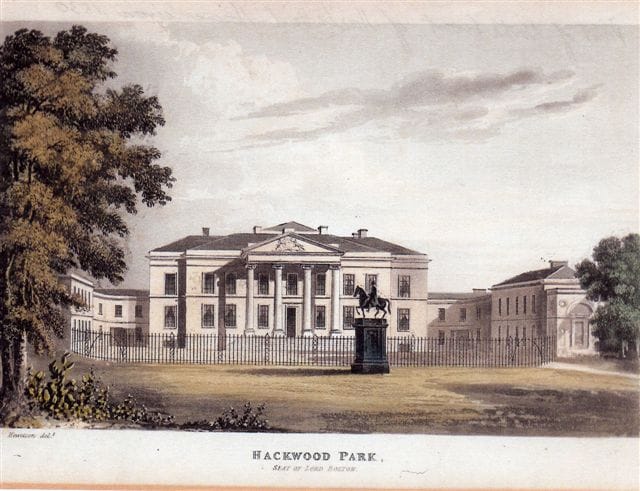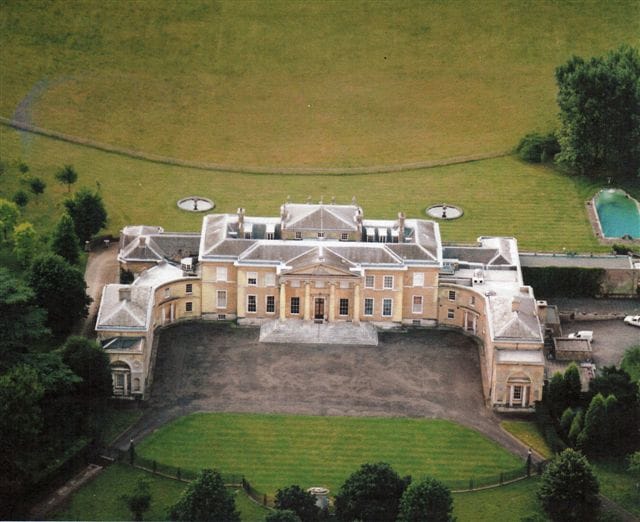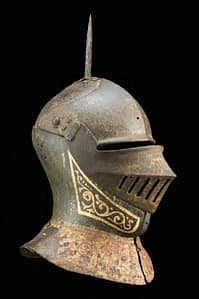The Tin Way – probably the oldest road in England – was marked out by the feet of Bronze Age men transporting tin from Cornwall to the eastern tribes. This road enters our area at Pack Lane, Oakley, follows along the line of the old bypass, and then continues some ten yards inside the Tunworth Road wall of Hackwood Park. As evidence of the presence of Bronze Age man in this area, there are two chieftains’ burial mounds close to the Brick Bridge over Tunworth Road. The Tin Way was crossed in Roman times by the road joining Silchester to Winchester. Thus we have the beginnings of the road system that now typifies modern Basingstoke.
The Saxons appreciated the importance of these crossroads and defended them against the Danes on three occasions, once at Battledown, Worting, once at Castle Field adjoining Basingstoke Cricket Ground, and once at a field still known as Danesfield which is on the Hackwood Estate within 150 yards of the Bronze Age burial mounds. The Normans also appreciated the importance of the road system that existed, and the Manor of Eastrop on the east side of Basingstoke was given to Sir Geoffrey de Brayfoef; the lands given to the Manor included Basing and the present day Hackwood.
After the death of King John in 1223 Henry de Brayfoef was given licence to enclose his wood at “Hagwood” with its timber, and in 1280 William de Brayfoef was given permission to enclose with a ditch and a fence part of his land at Hagwood, so that the king’s deer might neither enter nor leave. “Hagwood” gives a clue to the modern name “Hackwood”, inasmuch as the “Hacga” was a Saxon word for the hawthorn of which there are numerous examples at Hackwood. The Normans imported the fallow deer from their native land, and as they preferred to hunt this species, they wished to enclose the fallow and keep outside the native roe deer.
In the 16th century Hackwood was in the possession of the Paulet family, of which the most famous member was Sir William Paulet, the first Marquis of Winchester in 1551. His estates at that time included Eastrop, Winslade, Basing and Hackwood, which was the hunting and falconry part of his holdings. Basing House was the palatial seat of the Marquises of Winchester until its destruction by Oliver Cromwell in October 1645, following a siege of two years and eight months. Cromwell’s troops made extensive use of the road system around Basingstoke and the Marquis was able to hassle his troops during the period of the siege. Small wonder, therefore, that Cromwell ordered Basing House to be razed to the ground, and its contents destroyed when he eventually took the building.
At the restoration of Charles II the Marquis was given back his lands, but of course, he received no compensation for the loss of his house and its furniture. However, such was the extent of his estates that he was soon able to accumulate sufficient wealth to build his house on his hunting estate at Hackwood. Building commenced in 1683, when the house was built in the style of a very large hunting lodge with a Tudor style banqueting hall and ancillary rooms. Much of the furniture was supplied by Basingstoke craftsmen.
On the eve of the coronation of William and Mary in 1689, the Sixth Marquis of Winchester was created Duke of Bolton for services rendered to the throne. His son, the Second Duke of Bolton became Vice-Admiral, Lord Lieutenant, and Keeper of the Rolls of Hampshire and Dorset and Warden of the New Forest, and was instrumental in bringing about the succession of the House of Hanover to the English crown in 1714.
The Dukes of Bolton continued their interest in politics until the Sixth Duke failed to produce a son to inherit his title, and the estates went to his daughter who married Thomas Orde, who assumed the additional surname of “Powlett” in 1795, and was elevated to the peerage on 20th October 1797 by George III. He took the name of Baron Bolton of Bolton Castle in honour of his wife’s family. The first Lord Bolton wished to double the size of his residence and instructed Lewis Wyatt, a nephew of the famous James Wyatt to carry out the work. This naturally meant that more furniture was required; this was supplied by Gillows of Manchester.

The north front of Hackwood House, circa 1830.
In 1850 the Boltons decided to leave Hackwood and take up residence at Bolton Hall in Yorkshire, and accordingly, Hackwood House was let with all of its furniture. Notable tenants included Lord Westbury, the Attorney General and Chancellor of the Exchequer, Charles Hoare, one of the brothers who founded the famous bank, the Earl of Wilton, the Queen of the Belgians and her family after they were evicted from their native land by the Germans in the First World War, and the Marquis Curzon, a retired Viceroy of India. Following the death of the Curzons, the Boltons decided to sell their holdings in the Basingstoke area. Accordingly in 1935 the Hackwood, Winslade and Basing Estates were sold to Sir William Berry, who was soon to become Lord Camrose, and then in 1940 he was created a Viscount and assumed the title of Viscount Camrose of Hackwood Park. His family came from Merthyr Tydfil, and Camrose is a village nearby. The only present reminder of the Welsh connection is the presence of black welsh mountain sheep grazing at Hackwood.
Lord Camrose spent considerable sums of money on renovating and refurbishing Hackwood House and Spring Wood and the park, only to be confronted with the crisis of 1939. In 1940 he gave Hackwood House to the Royal Canadian Army as a hospital, free of payment, but on condition that it would be restored to him after the war in the same condition as when the gift was made. In the event, 16,500 troops were treated at Hackwood and by 1945 it had become the Basingstoke Neurological and Plastic Surgery Hospital, which was subsequently moved to Park Prewett and Rooksdown Hospital.
Lord Camrose had made the original purchase of Hackwood House with two things in mind, firstly to house his family of eight children, and secondly as a property where he could entertain his many rich, famous and influential friends away from London and Westminster. As a newspaperman he appreciated the pressures that the media, even in those days, could place upon prominent people, and his great desire was to take some of the pressure from them. Over a number of years he built up an atmosphere of peace and tranquillity at Hackwood where he entertained kings, princes and ambassadors, prime ministers and entertainers, and his son Seymour continued this when he inherited the title.

With his brother Michael, the Second Viscount Camrose continued to manage the Daily Telegraph and they were Editor and Chairman respectively to such an extent that Michael was himself awarded a life peerage and took the title of Lord Hartwell. The Second Viscount Camrose did not marry until he was 78 in 1986 when he took as his wife Princess Aly Khan, the mother of the present Aga Khan and his brother.
Upon the death of Lord Camrose his widow inherited a life interest in Hackwood and the surrounding estates, and it was only after her death in 1997 that the Berry family decided to sell the house, its contents and the estate.

So for twelve months an attempt was made to sell house, contents and estate, but this failed because prospective buyers with adequate funding did not wish to open the front door of the house to receive their guests to the accompaniment of the noise of the M3. Thus road and transport systems that had brought about the beginning of Hackwood and provided the great wealth to sustain it finally also killed it. At the end of one year Lord Hartwell as his brother’s executor, gave instructions for the furniture to be sold, and subsequently the properties were sold to a business consortium that after the purchase was completed proceeded to split the estate into small units. The house, stable block, three cottages and 160 acres were sold to one buyer and it is, therefore, hoped that this historic mansion will be preserved for future generations to admire from the public rights of way that pass close by.



